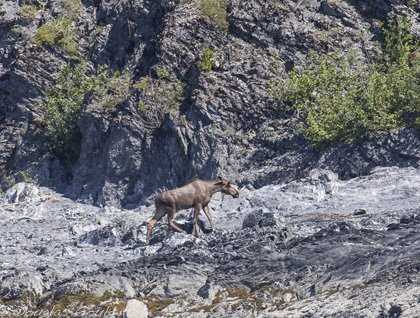Glacier Bay is an iconic destination, a keystone of Alaska’s natural history. Pristine, wild, and unspoiled are just a few words used to describe this giant basin. Carved thousands of years ago by ice thousands of feet thick, glaciers moved like slow-motion juggernauts, pulverizing everything in their path, leaving the earth’s crust deeply cleaved. As recently as 1750, the entire bay was filled with glacial ice. Since that time, the ice has receded and the ocean has filled the fjords, creating a bay that appears designed by nature to explore by small ship.
The National Geographic Sea Bird’s guests enjoyed a quiet night as the ship was tied up at the National Park Service docks in Bartlett Cove. Before 0600, our Park Rangers and guides were aboard, and the order was given to cast off. It’s 52 nautical miles from the entrance of the bay to Tar Inlet at the north end of the park, so an early start was in order to make the most of our daylight hours.
The weather was perfect, with mostly clear skies and calm seas. As the ship steamed north, guests with fresh coffee gathered on the bow and enjoyed views of sea otters, humpback whales, marbled murrelets, pigeon guillemots plus a variety of cormorants, loons, and ducks. During breakfast, expedition leader Rab Cummings introduced our two Park Rangers who will be aboard all day to interpret the sights and history of Glacier Bay.
As the breakfast dishes were cleared, the ship sailed passed Marble Island, perhaps an acre of rock favored by Steller’s sea Lions and tufted puffins. The ship was able to maneuver quite close to the island—fortunately the National Geographic Sea Lion’s forward decks are large enough that every guest had a front row seat!
The weather continued to cooperate, allowing us to enjoy a leisurely passage along Glacier Bay’s eastern shores, admiring the geology and searching for more terrestrial wildlife. At about 10 a.m., as we neared a large nude dome of rock known as “Gloomy Knob” our naturalist team spied an adult moose climbing out of the water and onto the beach. She seemed neither interested in nor disturbed by us but soon vanished into the short deciduous growth trees just above the beach.
Within a few minutes, the western face of Gloomy Knob had quite a few mountain goats, some almost at the ship’s level. A number of kids grazed under the watchful eyes of their nannies. Soon, it was time to head north towards our ultimate destination—the terminal glaciers of Tar Inlet. The water turned a light cappuccino color from the huge quantities of glacial silt as we neared the Great Pacific Glacier and her sister, the Margerie Glacier.
Thousands of black-legged kittiwakes nest on the cliffs adjacent to the glaciers, and at times the sky seemed filled with flashy gray-and-white colors of their wings while we watched enormous chunks of ice calve from Margerie Glacier’s face that sent up great splashes from the water.
The rest of the day was spent relaxing as National Geographic Sea Bird sailed south and returned to Bartlett Cove after dinner to drop off our park guides and have a chance for an evening constitution on shore. Another glorious day of adventure comes to a close…







